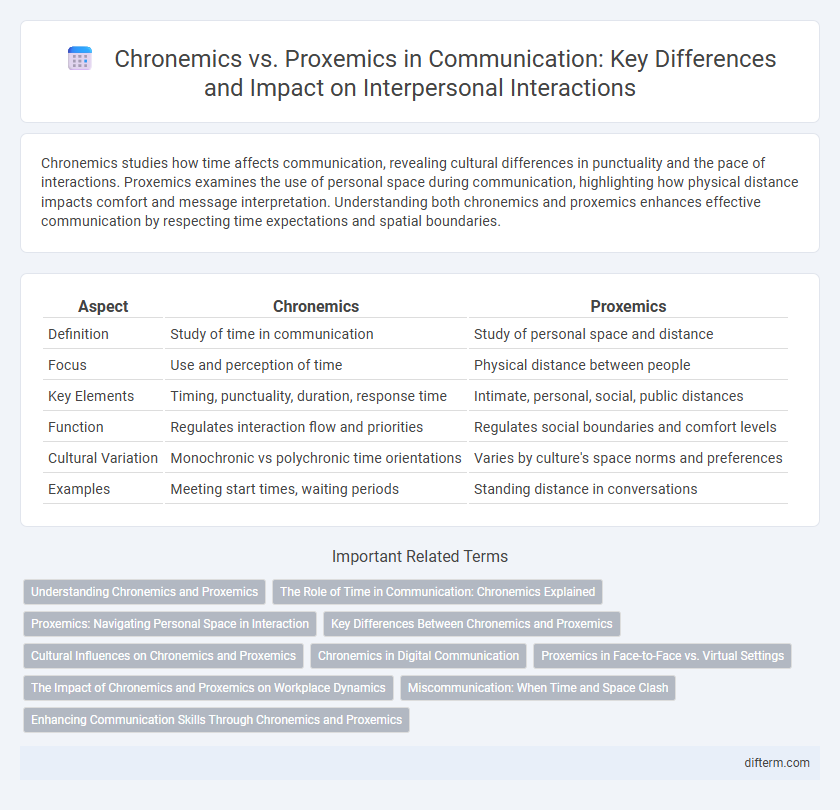Chronemics studies how time affects communication, revealing cultural differences in punctuality and the pace of interactions. Proxemics examines the use of personal space during communication, highlighting how physical distance impacts comfort and message interpretation. Understanding both chronemics and proxemics enhances effective communication by respecting time expectations and spatial boundaries.
Table of Comparison
| Aspect | Chronemics | Proxemics |
|---|---|---|
| Definition | Study of time in communication | Study of personal space and distance |
| Focus | Use and perception of time | Physical distance between people |
| Key Elements | Timing, punctuality, duration, response time | Intimate, personal, social, public distances |
| Function | Regulates interaction flow and priorities | Regulates social boundaries and comfort levels |
| Cultural Variation | Monochronic vs polychronic time orientations | Varies by culture's space norms and preferences |
| Examples | Meeting start times, waiting periods | Standing distance in conversations |
Understanding Chronemics and Proxemics
Chronemics studies how individuals perceive and use time in communication, influencing punctuality, response delays, and turn-taking patterns. Proxemics examines physical distance in interactions, revealing cultural norms and personal comfort zones that affect nonverbal messages. Understanding chronemics and proxemics enhances effective communication by aligning timing and spatial behavior with social expectations.
The Role of Time in Communication: Chronemics Explained
Chronemics studies the impact of time on communication, revealing how cultural perceptions of punctuality, waiting, and time management influence interaction effectiveness. Understanding monochronic versus polychronic time orientations helps decode individuals' communication patterns and social behaviors. Time's role in communication shapes expectations, power dynamics, and relationship-building across diverse contexts.
Proxemics: Navigating Personal Space in Interaction
Proxemics studies how individuals use and perceive personal space during communication, influencing comfort and interaction dynamics. Different cultures have distinct spatial norms, where closer distances can signal intimacy or aggression, and larger distances imply formality or detachment. Understanding proxemics helps navigate social boundaries, prevent misunderstandings, and enhance effective communication in both personal and professional settings.
Key Differences Between Chronemics and Proxemics
Chronemics studies the role of time in communication, such as punctuality, waiting time, and the perceived value of time, while proxemics examines the use of physical space, including personal distance and territoriality. Chronemics influences communication by controlling turn-taking and scheduling, whereas proxemics affects interpersonal interactions through spatial behavior and cultural norms around personal space. Understanding these key differences helps improve nonverbal communication effectiveness by addressing both temporal and spatial dimensions.
Cultural Influences on Chronemics and Proxemics
Cultural influences significantly shape chronemics and proxemics, with monochronic cultures valuing strict adherence to schedules while polychronic cultures prioritize relationship-building over punctuality. In terms of proxemics, individualistic societies maintain larger personal spaces compared to collectivist cultures that favor close physical proximity to reinforce social bonds. Understanding these cultural variations is essential for effective cross-cultural communication and avoiding misunderstandings related to time perception and spatial behavior.
Chronemics in Digital Communication
Chronemics in digital communication examines how time influences interactions, such as response latency in emails and messages shaping perceived urgency and relational closeness. The asynchronous nature of digital platforms alters traditional time expectations, impacting conversational flow and interpretation of intent. Understanding digital chronemics enhances effective communication by managing timing cues to foster clearer and more respectful exchanges.
Proxemics in Face-to-Face vs. Virtual Settings
Proxemics in face-to-face communication involves managing physical distance to convey intimacy, authority, or social hierarchy, typically categorized into intimate, personal, social, and public zones. In virtual settings, proxemics adapts through screen presence, camera framing, and interface layout, affecting perceived closeness and engagement despite the lack of physical space. Understanding these differences enhances communication effectiveness by aligning spatial cues with interaction context in both environments.
The Impact of Chronemics and Proxemics on Workplace Dynamics
Chronemics, the study of time in communication, influences workplace dynamics by shaping punctuality, scheduling, and perceptions of efficiency, which can affect collaboration and productivity. Proxemics, the study of personal space, impacts interactions by determining comfort levels and communication boundaries among colleagues, influencing team cohesion and conflict resolution. The interplay between chronemics and proxemics creates a framework for understanding nonverbal cues that optimize workplace communication and enhance organizational culture.
Miscommunication: When Time and Space Clash
Miscommunication often arises when chronemics, the study of time in communication, clashes with proxemics, the study of personal space, leading to conflicting interpretations of messages. For example, arriving late (a chronemic cue) can be seen as disrespectful in cultures valuing punctuality, while maintaining close physical distance (a proxemic cue) may be perceived as intrusive in cultures with strong space boundaries. Understanding these temporal and spatial differences is essential to prevent misunderstandings and improve intercultural communication effectiveness.
Enhancing Communication Skills Through Chronemics and Proxemics
Mastering chronemics--the study of time in communication--and proxemics--the use of personal space--significantly enhances interpersonal interactions by aligning timing and spatial awareness with cultural norms. Understanding pauses, response times, and appropriate physical distances fosters clarity, reduces misunderstandings, and builds stronger connections in both personal and professional settings. Effective use of chronemics and proxemics improves nonverbal communication, allowing individuals to convey respect, attentiveness, and emotional nuance with greater precision.
chronemics vs proxemics Infographic

 difterm.com
difterm.com